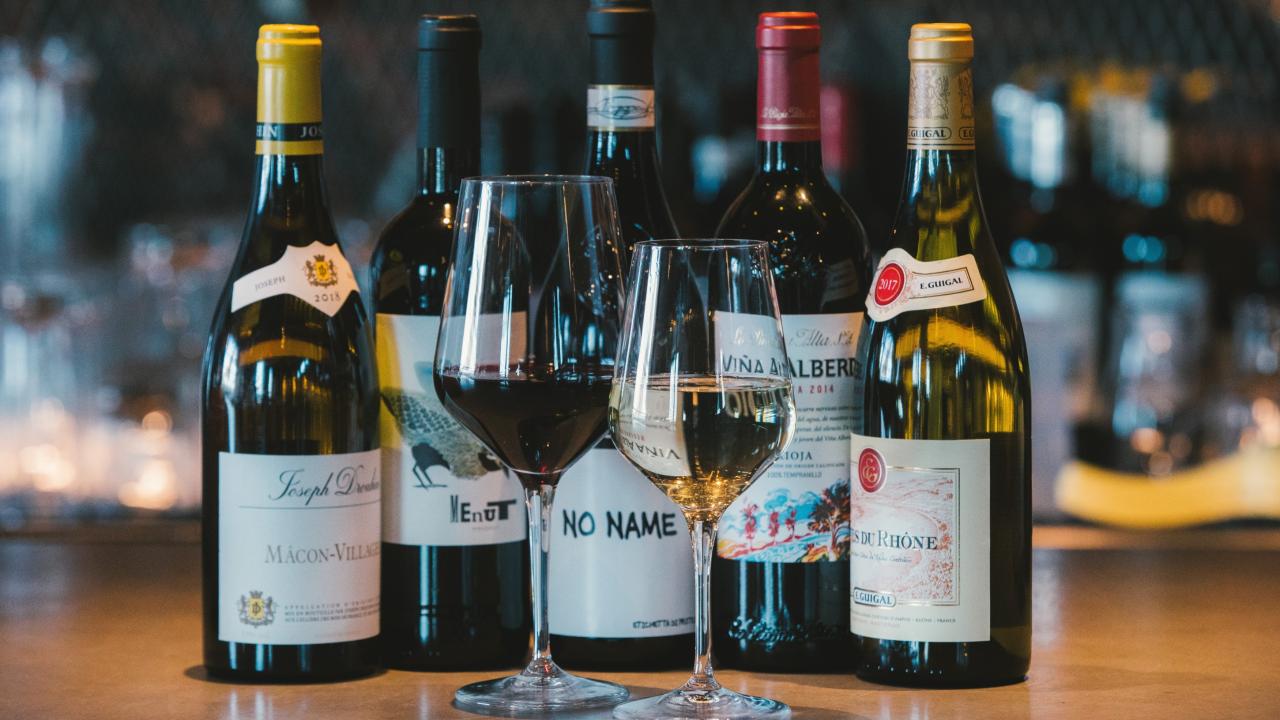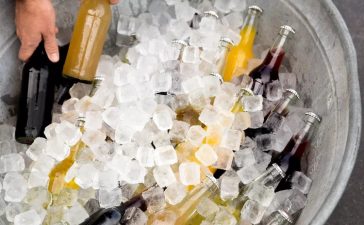
Dreaming of building a wine collection? While some may casually visit the wine store to grab a bottle for dinner, we, as wine enthusiasts, find ourselves scouring the shelves for hours in search of special whites and reds to add to our cellar. With an array of delectable wines, elusive producers, and limited-edition bottles, proper storage becomes paramount. Whether you plan to keep a bottle for a few months or a decade, there are certain guidelines to ensure that the wine maintains its optimal condition. These storage principles apply to all types of wine, including sparkling varieties like Champagne, as well as white, red, rosé, dessert, and even fortified wines.
After all, the last thing you want is for your wine to transform into vinegar before you have the chance to savor all the intricate flavors and aromas it has to offer.
Store On The Side
All wine should be stored horizontally. You’ll observe this practice in every custom wine cellar, wine refrigerator, built-in kitchen wine rack, and even high-end wine shops; the racks are designed in a way that allows bottles to rest on their sides. This not only presents an elegant appearance but also serves a crucial function: it keeps the cork in contact with the liquid, maintaining its moisture. This, in turn, helps to slow down oxidation as air slowly permeates through the cork, preventing premature aging and spoilage. We have a particular preference for wine storage with drawers, as they allow you to easily pull them out and view the labels of your wines.
Keep It Cool
Displaying your wine bottles on your kitchen counter may create an aesthetically pleasing scene, but it’s not the best approach for preserving your vino. Wine thrives in stable, cool conditions. Elevated temperatures can warm the liquid and accelerate its spoilage. The ideal temperature for wine storage is around 55 degrees Fahrenheit, commonly referred to as “cellar temperature.” This temperature range is suitable for all types of wine, including sparkling wines, whites, reds, and fortified styles like Port and Madeira. (It’s important to note that cellar temperature differs from serving temperature, which can range from 45 degrees Fahrenheit to room temperature.) This is why wine refrigerators or temperature-controlled wine rooms are favored for long-term wine storage.
If you don’t have access to a dedicated refrigerated space, particularly for those residing in urban areas, look for a cool corner within your home. Ensure that wine is kept away from heat sources such as furnaces, stoves, and fireplaces. This also means avoiding placing bottles on top of the kitchen refrigerator. Pantries can be an excellent alternative for wine storage.
For those who aim to maintain wine at the ideal 55 degrees Fahrenheit, investing in a wine refrigerator is a wise choice. These appliances come in various sizes, ranging from compact countertop units capable of holding six bottles to expansive, wall-mounted units with the capacity to store hundreds of bottles. Many wine refrigerators can also be seamlessly integrated into your kitchen or bar area, enhancing both functionality and aesthetics.
There’s Such a Thing as “Too Cold”
While unopened wines do prefer cooler environments, they don’t fare well in a freezing-cold kitchen refrigerator. That bottle of Champagne that has been sitting in the fridge door for months? It’s time to remove it. Kitchen refrigerators typically maintain temperatures around 35 to 40 degrees Fahrenheit, which is ideal for food preservation but far too cold for wine bottles. If the wine freezes, it can exert enough pressure to push the cork out as the liquid expands. Moreover, refrigerators lack the necessary humidity, which can lead to the drying out of wine corks and premature oxidation of your wine.
QUICK TIP
If you wish to cool a bottle of white, rosé, sparkling, or any other type of wine for later consumption, place the bottle horizontally in the refrigerator approximately one hour before you intend to uncork it.
It’s Better in the Dark
Have you ever noticed that wines, particularly Champagne, often come in tinted bottles? There’s a specific reason for this. Wines benefit from being stored in darkness, and thick, colored glass bottles serve to keep light out. Light can have several detrimental effects on wine.
Firstly, light generates heat. Thus, leaving a bottle exposed to light on a shelf near a window, for instance, can lead to quicker deterioration compared to storing it inside a piece of furniture. Sunlight, in particular, warms the wine without providing the necessary humidity, which can result in cork drying out and wine oxidizing at inopportune times.
Furthermore, UV rays have the ability to break down the chemicals and molecules responsible for the wine’s gradual aging process. This disruption can throw off the balance of the aging process and potentially ruin your wine. To prevent these issues, it’s essential to store your bottles away from direct sunlight, avoid brightly lit rooms, and refrain from using fluorescent light bulbs near your aging wine.
Serve It Up
For some, a temperature of 55 degrees may appear too cool for drinking, particularly when it comes to red wines freshly retrieved from the cellar or wine refrigerator. When you’re ready to open a bottle, consider allowing it to gradually reach room temperature by either decanting the wine or leaving it on the table for a few minutes.
As for white, rosé, dessert, and sparkling wines, you have a couple of options: you can either place the bottle in an ice bucket to further chill it by a few degrees, or you can put it in the refrigerator for about 15 minutes before serving. However, it’s essential to avoid adding ice cubes directly to the wine in the glass, as this will dilute the liquid and mute its flavors.
Save for Another Day
Now that you’ve stored that precious bottle for what feels like an eternity, you open it and savor it, but you don’t finish the bottle. There are best practices for preserving open wine as well. The key is to minimize the wine’s exposure to oxygen, as oxygen can turn wine into vinegar. Many people simply reseal the bottle with the cork, but we advise against this approach. Firstly, the cork is not airtight, so oxygen can still seep in. Secondly, the cork can break, causing pieces to fall into the liquid when you attempt to open the bottle again.
Instead, the optimal method involves using a vacuum pump and storing the bottle upright in the refrigerator, away from the light source. Why is this recommended? Firstly, the vacuum pump effectively seals the wine after removing as much oxygen as possible. Storing the bottle upright limits the surface area of liquid exposed to air (in comparison to a bottle lying on its side), and, of course, you want to minimize its contact with light. When stored this way, wines can remain good for three to five days. There are similar vacuum systems designed for sparkling wines that help maintain the carbonation over time and prevent the cork from popping due to pressure.
For serious wine enthusiasts, an inert gas preservation system may be a better choice. These systems, such as the well-known Coravin, replace the extracted wine with argon gas, allowing you to enjoy a special bottle over the course of months (yes, months!). This method is also suitable for those who prefer an occasional glass rather than regular consumption. However, with this system, you never remove the cork. The preservation system is used with the cork in place, so you must commit to this option before grabbing the corkscrew.
But what about fortified wines, you ask? Well, fortified wine styles, such as Madeira, Sherry, and Vermouth, can be stored on a bar cart, provided the room maintains a reasonable temperature. These styles of wine have been fortified with alcohol, which serves as a preservative. Many of these wines can technically remain open for several years, although you’ll enjoy the best quality by consuming them within a few months. As for Ports, the storage recommendations vary by style. Vintage ports should be stored similarly to red wines—in the refrigerator for a few days—while Tawny styles remain good for two months.
You Might Also Like
Essentials for a Backyard BBQ
To ensure your summer BBQ is a resounding success, consider these essential tools that will take your backyard party to...
Rainy Day Bliss: Fun Indoor Activities to Brighten Up a Dreary Day
When the rain starts pouring, and outdoor plans get washed away, there's no need to despair. Rainy days offer a...
6 Pro-Recommended Summer Entertaining Tips
Summer brings the perfect opportunity to host friends and family outdoors, with its long nights and warm weather creating an...
Winter Wonderland: Fun and Productive Activities to Embrace December
Winter has arrived, and with it comes the holiday season, filled with festive decorations, grocery shopping, and gift-giving. In those...











